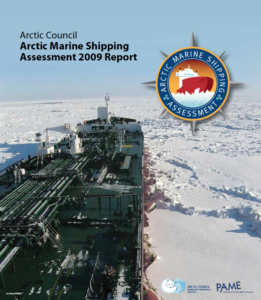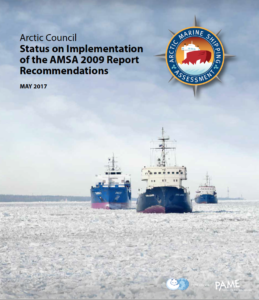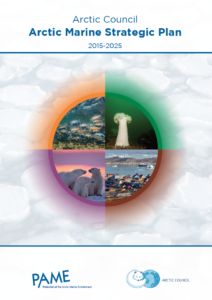Peter Lobner
The Arctic Council describes itself as, “….the leading intergovernmental forum promoting cooperation, coordination and interaction among the Arctic States, Arctic indigenous communities and other Arctic inhabitants on common Arctic issues, in particular on issues of sustainable development and environmental protection in the Arctic.” The council consists of representatives from the eight Arctic states:
- Canada,
- Kingdom of Denmark (including Greenland and the Faroe Islands)
- Finland
- Iceland
- Norway
- Russia
- Sweden
- United States
In addition, six international organizations representing Arctic indigenous people have permanent participant status. You’ll find the Arctic Council’s website at the following link:
http://www.arctic-council.org/index.php/en/
One outcome of the Arctic Council’s 2004 Senior Arctic Officials (SAO) meeting in Reykjavik, Iceland was a call for the Council’s Protection of the Arctic Marine Environment (PAME) working group to conduct a comprehensive Arctic marine shipping assessment as outlined in the AMSP. The key result of that effort was The Arctic Marine Shipping Assessment 2009 Report (AMSA), which you can download here:
https://oaarchive.arctic-council.org/handle/11374/54
This report provided a total of 17 summary recommendations for Arctic states in the following three areas:
I. Enhancing Arctic marine safety
A. Coordinating with international organizations to harmonize a regulatory framework for Arctic maritime safety.
B. Supporting International Maritime Organization (IMO) standards for vessels operating in the Arctic.
C. Developing uniform practices for Arctic shipping governance, including in areas of the central Arctic ocean that are beyond the jurisdiction of any Arctic state.
D. Strengthening passenger ship safety in Arctic waters
E. Supporting development of a multi-national Arctic search and rescue capability.
II. Protecting Arctic people and the environment
A. Conducting surveys of Arctic marine use by indigenous people
B. Ensuring effective engagement with Arctic coastal communities
C. Identifying and protecting areas of heightened ecological and cultural significance.
D. Where appropriate, designating “Special Areas” or “Particularly Sensitive Areas”
E. Protecting against introduction of invasive species
F. Preventing oil spills
G. Determining impacts on marine animals and take mitigating actions
H. Reducing air emissions (CO2, NOx, SO2 and black carbon particles)
III. Building the Arctic marine infrastructure
A. Improving the Arctic infrastructure to support development while enhancing safety and protecting the Arctic people and environment, including icebreakers to assist in response.
B. Developing a comprehensive Arctic marine traffic awareness system and cooperate in development of national monitoring systems.
C. Developing a circumpolar environmental response capability.
D. Investing in hydrographic, meteorological and oceanographic data needed to support safe navigation and voyage planning.
The AMSA 2009 Report is a useful resource, with thorough descriptions and findings related to the following:
- Arctic marine geography, climate and sea ice
- History of Arctic marine transport
- Governance of Arctic shipping
- Current marine use and the AMSA shipping database
- Scenarios, futures and regional futures to 2020 (Bering Strait, Canadian Arctic, Northern Sea Route)
- Human dimensions (for a total Arctic population of about 4 M)
- Environmental considerations and impacts
- Arctic marine infrastructure
Four status reports from 2011 to 2017 documented the progress by Arctic states in implementing the 17 summary recommendations in AMSA 2009. The fourth and final progress report entitled, “Status of Implementation of the AMSA 2009 Report Recommendations; May 2017,” is available at the following link:
Through PAME and other working groups, the Arctic Council will continue its important role in implementing the Arctic Marine Strategic Plan. You can download the current version of that plan, for the period from 2015 – 2025, here:
https://oaarchive.arctic-council.org/handle/11374/413
Source: Arctic Council
For example, on 6 November 2017, the Arctic Council will host a session entitled, “The global implications of a rapidly-changing Arctic,” at the UN Climate Change Conference COP23 meeting in Bonn, Germany. For more information on this event, use this link:
http://www.arctic-council.org/index.php/en/our-work2/8-news-and-events/473-cop23


